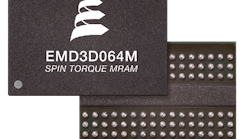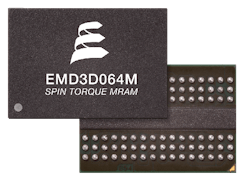O’Hare: Our MRAM [magnetoresistive random access memory] business and product breadth continue to grow. Everspin’s first-generation Toggle MRAM products are experiencing robust growth as a result of new customer design wins and market-share gains. We expect this to continue as we bring new offerings to the market, such as the 1-Mbit Quad SPI and automotive temperature grade for the 4-Mbit SPI and 16-Mbit asynchronous SRAM interface products. MRAM has become the solution of choice for applications that require high write endurance, long data retention, and non-volatility at SRAM performance levels. Enterprise RAID, transportation, and industrial automation are just a few of the markets we serve.
ST-MRAM at Everspin has progressed very well. In a collaborative effort at the recent Flash Memory Summit in Santa Clara, Calif., Everspin, our ecosystem partners, and customers made several key announcements geared toward the production readiness of our first commercial ST-MRAM, the EMD3D064M. This includes demonstrations of the device working in both memory and storage applications, DDR3 controller compatibility, and most importantly, a customer showcasing products that employ the EMD3D064M. Mangstor has taken the lead with its newly announced SSD that operates with NVMe over PCIe 3.0, using the ST-MRAM as a write cache. We are very excited to be enabling this new class of performance in storage devices.
Wong: How does Spin Torque MRAM technology enable a persistent DRAM class of products? (What is the value of persistent DRAM versus standard DRAM?)
O’Hare: Everspin’s ST-MRAM has delivered on the promise of a non-volatile, high-endurance memory with very high bandwidth. This combination of features gives us the ability to utilize a DDR3 interface, resulting in a persistent DRAM class of products. ST-MRAM technology, with its very fast switching time and lower current density for writing, has allowed us to move from products that capture, record, and protect vital system data into the mainstream data path of storage systems. Now systems can get ultra-low latency, multi-gigabit-per-second bandwidth, and protection of critical data in the event of power loss, all in one product.
Wong: Will MRAM and ST-MRAM replace embedded memory, such as flash and SRAM?
O’Hare: Yes, we strongly believe that MRAM is well suited to become the preferred solution for embedded memory. It offers clear advantages over embedded flash and SRAM, including very high endurance; extremely fast writes; simple integration with CMOS logic processes; a smaller bit cell and very low leakage versus SRAM; bit and byte addressability; and flexibility in design choices to optimize for a given solution. We are shipping embedded MRAM in volume today, and expect that this will proliferate as ST-MRAM moves to production.
Wong: Where, in what markets, will ST-MRAM products first be deployed—and what are the user-perceivable benefits of ST-MRAM to these markets?
O’Hare: Enterprise storage applications are a natural market for the first deployment of ST-MRAM. The tangible benefit of ST-MRAM in this market is that there is a reliability improvement that comes with the inherent protection of critical data in the event of power loss. This means that users will be assured that their last data requests and data in-flight will be captured in ST-MRAM, without the use of a backup energy source such as batteries or supercapacitors.
ST-MRAM simplifies system design while providing the added benefit of having certain critical data immediately available upon power up because the data is stored in RAM, close to the processor. RAID metadata or SSD FTL tables will be readily accessible without a download from storage devices. While Everspin is focused on the storage market, it is clear that these same ST-MRAM user benefits will apply to most compute applications as well.
This file type includes high resolution graphics and schematics when applicable.
Wong: Will Spin Torque MRAM replace DRAM or NAND flash?
O’Hare: While both DRAM and NAND face many challenges to continue scaling as they break the 20-nm barrier, it seems clear that innovation will continue to enable further technology advances for both of these mainstream semiconductor memories. The promise of ST-MRAM is that the technology will scale more aggressively over the next few years and reach a point where it moves from an emerging class to a mainstream class. A high-endurance, low-latency tier of memory such as ST-MRAM will extend the useful life of flash-based storage products, and it will be a better solution than DRAM in systems that can’t afford a loss of data, or suffer the overhead of longer refresh cycles. ST-MRAM is a strong complement to these proven technologies and is aiming to take its own place as a mainstream technology in the future.
Wong: What are some specific things Everspin is doing to enable MRAM and ST-MRAM proliferation into the market?
O’Hare: Our effort to proliferate MRAM in the market is multi-faceted. The first is to commercialize products and achieve volume on ST-MRAM with a persistent DRAM class of performance. This involves building the ecosystem through the important partners that provide DDR3 controller IP. The first to get there are Cadence, Altera, and Northwest Logic, but many others are lined up. We are providing evaluation boards that give customers a platform to validate the controller IP with test software in conjunction with partners. In addition to enabling the design environment, we are partnering to build the manufacturing infrastructure that will be needed to bring MRAM into the mainstream. Not only will there be dedicated capacity for the ST-MRAM memory components, but the technology is planned to be available for widespread deployment as an embedded memory solution. It’s an exciting time for Everspin and the memory market as MRAM moves into the mainstream.
Joe O’Hare has 30 years of experience in the semiconductor industry, holding a variety of engineering, marketing, and executive positions at firms such as TI, Lucent, and Agere Systems with a focus on the magnetic and solid-state storage industries. He is now leading the product marketing effort at Everspin Technologies, bringing new MRAM solutions to the market with an emphasis on accelerating data storage.



